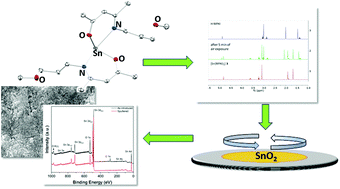Additive-free spin coating of tin oxide thin films: synthesis, characterization and evaluation of tin β-ketoiminates as a new precursor class for solution deposition processes†
Abstract
The fabrication of SnOx in thin film form via chemical solution deposition (CSD) processes is favored over vacuum based techniques as it is cost effective and simpler. The precursor employed plays a central role in defining the process conditions for CSD. Particularly for processing SnO2 layers that are appealing for sensor or electronic applications, there are limited precursors available for CSD. Thus the focus of this work was to develop metalorganic precursors for tin, based on the ketoiminate ligand class. By systematic molecular engineering of the ligand periphery, a series of new homoleptic Sn(II) β-ketoiminate complexes was synthesized, namely bis[4-(2-methoxyethylimino)-3-pentanonato] tin, [Sn(MEKI)2] (1), bis[4-(2-ethoxyethylimino)-2-pentanonato] tin, [Sn(EEKI)2] (2), bis[4-(3-methoxypropylimino)-2-pentanonato] tin, [Sn(MPKI)2] (3), bis[4-(3-ethoxypropylimino)-2-pentanonato] tin, [Sn(EPKI)2] (4) and bis[4-(3-isopropoxypropylimino)-2-pentanonato] tin, [Sn(iPPKI)2] (5). All these N-side-chain ether functionalized compounds were analyzed by nuclear magnetic resonance (NMR) spectroscopy, electron impact mass spectrometry (EI-MS), elemental analysis (EA) and thermogravimetric analysis (TGA). The solid state molecular structure of [Sn(MPKI)2] (3) was eludicated by means of single crystal X-ray diffraction (SCXRD). Interestingly, this class of compounds features excellent solubility and stability in common organic solvents alongside good reactivity towards H2O and low decomposition temperatures, thus fulfilling the desired requirements for CSD of tin oxides. With compound 3 as a representative example, we have demonstrated the possibility to directly deposit SnOx layers via hydrolysis upon exposure to air followed by heat treatment under oxygen at moderate temperatures and most importantly without the need for any additive that is generally used in CSD. A range of complementary analytical methods were employed, namely X-ray diffraction (XRD), Rutherford backscattering spectrometry (RBS), nuclear reaction analysis (NRA), X-ray photoelectron spectroscopy (XPS) and scanning electron microscopy (SEM) to analyse the structure, morphology and composition of the SnOx layers.



 Please wait while we load your content...
Please wait while we load your content...